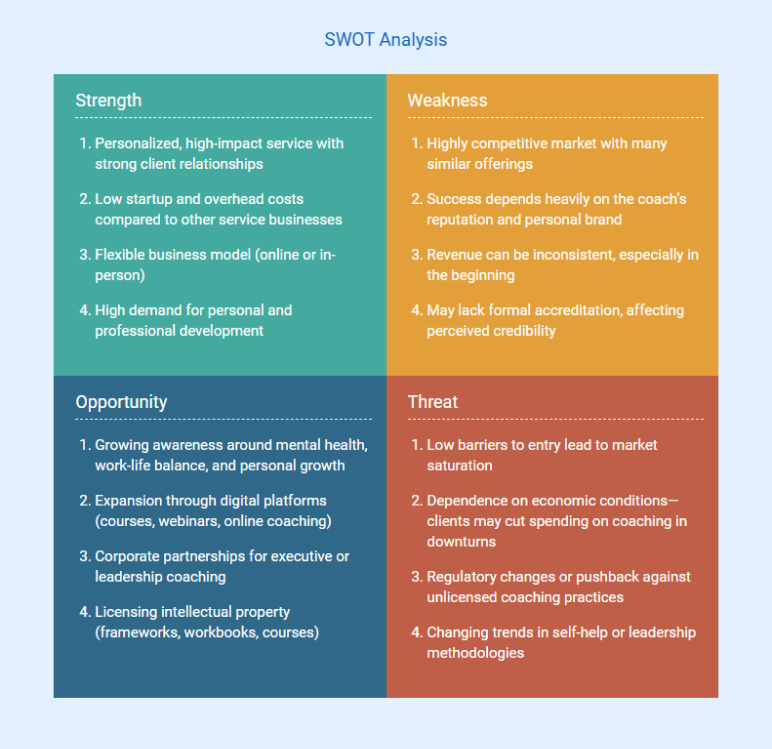Being a new coach often means spending more time chasing clients than actually coaching. And that’s not what you signed up for!
Instead of helping people, you’re just guessing at prices, competing with countless other coaches, and wondering if your business will ever pay the bills.
That’s where a solid business plan helps; it gives structure to your ideas and makes your coaching practice look credible and sustainable.
To make things easier, we’ve created a free coaching business plan template. It guides you through each section step by step with examples and prompts, so you don’t have to start from scratch. Download the template below to get started.
Keep reading, and we’ll guide you through writing a successful coaching business plan with clarity and confidence.
How to write a coaching business plan?
The easiest way to write a coaching business plan is to break it into clear sections. Here’s a step-by-step guide on what to include:
1. Executive Summary
The executive summary is the opening section of your coaching business plan. Its purpose is to give readers a quick but clear overview of your business.
Make it brief, preferably a page or two. You can begin by introducing your business with its name, location, and the type of coaching you provide.
Following it, a concise mission statement can be included that will convey the true purpose of your business. You can also include a vision statement, which outlines what you ultimately want to achieve.
Look below for reference:

After that, do a brief description of your services, be it one-on-one coaching, group, or corporate programs.
Next, describe your target audience in plain terms. For example, you may work with mid-level managers, small business owners, or professionals going through career transitions.
Be specific on how you’ll earn money, possibly by conducting hourly sessions, packages, or contracts with companies.
Finally, wrap it up with a financial snapshot. Share high-level projections like expected revenue for the first year and where growth is likely to come from (online coaching or corporate partnerships).
In case you’re in need of funding, provide the amount of money required and its purpose.
By laying out these essentials, you set the stage for the rest of your business plan.
2. Business Overview
The business overview section gives readers the key details about your coaching company. It indicates you know who you are, what you bring to the table, and where you’re headed.
Let’s go over what the key things you’ll need to include in this section:
Business name
State your registered business name and the legal entity type (sole proprietorship, LLC, or partnership), as it affects licensing and taxes.
Location
Explain where you’re based and how you deliver services (local, national, online, or hybrid).
Example: Austin, Texas, with clients across the U.S. via Zoom
Mission statement
A clear statement of your business purpose today. For example: Helping professionals achieve personal and career growth through practical coaching programs
Company history (if any)
If you already have experience in coaching, training, or related fields, summarize it briefly.
Business goals
Show where you’re headed. Split them into:
- Short-term goals (next 12 months) like acquiring your initial clients, initiating group coaching, or enhancing your online visibility.
- Long-term goals (3–5 years) like introducing corporate initiatives, releasing materials, or branching into new markets.
Once you’ve covered these basics, you’ll have a clear snapshot of your business that readers can grasp at a glance.
Say goodbye to boring templates
Build your business plan faster and easier with AI
Plans starting from $14/month

3. Market Analysis
Your market analysis explains the external environment your coaching business will operate in. It answers key questions: Who are your clients? How big is the market? Who are your competitors? And where do you fit in?
Instead of vague descriptions, aim to use facts, numbers, and simple examples. This will give your plan credibility.
In your analysis, make sure to include:
- The size, growth, and trends of the coaching industry
- Insights into your target audience based on demographics and goals
- The main needs your coaching services will address
- Key competitors and how your services differ from theirs
- Opportunities in the market that you can make use of
It’s a good practice to support your analysis with numbers or research from reliable sources like the International Coaching Federation (ICF), IBISWorld, or Statista. Including actual market size or growth statistics makes your plan stronger and more convincing.
For instance, the U.S. life coaching industry is projected to continue its steady growth until 2030, with an increase in both in-person and online coaching, and an anticipated CAGR of 4.9%.

This type of chart will make the plan more realistic, and the reader will notice the market potential at one glance. To take it further, you can also show how your business fits into this landscape by linking back to your clients and competitors.
A simple way to do this is through tools like a SWOT analysis, a buyer persona, or a competitor comparison table.
The example below shows how a SWOT analysis can be applied to a coaching practice:

4. Services Offered
This section of your coaching business plan explains the services you’ll provide and how they create value for clients. It should give readers a clear sense of what you offer, how it’s delivered, and how you’ll earn revenue.
Start with the main services you plan to provide. They could be any from below:
| Service | Description (what to include) | Average prices |
|---|---|---|
| One-on-one coaching | Describe the subject of the session (career, life, executive, wellness), the expected outcome, and what approach will be used. |
$150 per session or $800 for a 6-session package |
| Group coaching program | Describe the group size, common themes covered (career growth, leadership, etc.), and benefits of learning with peers. |
$300 per participant for a 6-week program |
| Corporate workshops | Summarize the target audience (teams, leaders), topics covered (leadership, communication, team development), and format. |
$1,500 per half-day workshop |
| Online resources | Mention the type of resource (courses, workbooks, toolkits), how it supports clients, and key outcomes. |
$50–$200 per resource |
Along with your services, specify how the sessions are to be conducted, i.e., online (Zoom) and/or in-person, or both, in order to show accessibility and flexibility.
To make this section even more effective, you can also include information about what is unique about your approach, for instance, goal-setting models that are systematic, progress-tracking tools, or flexible schedules.
If you plan to add more services in the future, like retreats or certification programs, this is also the right place to mention them.
In short, this section shows readers what you’re offering, how you deliver it, and why clients will see value in paying for it.
5. Marketing & Sales Plan
Coaching skills alone aren’t enough; you need strategies to reach the right people, build trust, and turn them into paying clients. This section explains how you’ll reach potential clients, attract them to your coaching business, and convert them into long-term customers.
You may break this section down into two parts:
Marketing plan
Discuss how you’ll reach your target clients and build awareness about your coaching services. Some techniques you may try:
Website: Build a professional website to highlight your services, showcase testimonials, and share clear pricing details.
Social media: Use LinkedIn, Instagram, or Facebook to share tips on coaching, testimonials of success, and the occasional special offer.
Local marketing: Provide complimentary workshops, participate in networking events, or present talks at coworking spaces and community hubs to allow clients to experience your coaching approach.
Partnerships: Network with HR companies, health and wellness facilities, or privately owned companies that can refer your services to their clients or employees.
Offers and Ads: Run targeted LinkedIn ads for professionals in your niche. Give initial discounts or complimentary consultation sessions for new clients
Sales plan
Explain how you’ll convert interested people into paying clients. For that, you can:
- Offer a free of charge, 30-minute consultation call to create benefit prior to sale.
- Present transparent packages (single session, package of 6 sessions, or corporate-related packages).
- Use online scheduling and billing (Calendly, Stripe, PayPal) tools to make registration easy.
- Keep in contact through follow-up by email or LinkedIn
To keep clients coming back, think about how you can make their journey feel valuable and rewarding. Regular progress check-ins show them they’re moving forward, while small incentives encourage them to stay longer or refer friends.
Adding extra documents like workbooks or accountability reports helps them feel supported beyond the sessions.
6. Operations Plan
The operations plan explains how your coaching business will function on a daily basis. It shows the systems, tools, and workflows you’ll rely on to deliver services, manage clients, and handle administrative work.
This section gives readers confidence that your business can run smoothly and consistently.
Here’s how to plan your operational aspects:
- Explain how potential clients will find you, schedule, and start to work with you.
- Explain how the coaching sessions will be conducted (online, in-person, or a combination of the two).
- Describe the step-by-step workflow of consultation to ongoing sessions.
- List the tools and platforms you’ll use for scheduling, communication, billing, and progress tracking.
- Explain organizational functions like bookkeeping, invoice processing, and marketing to be done.
- Note whether you are working solo or with the help of supporting staff/contractors (accountant, virtual assistant, help with social media).
- Make note of any procedures that promote an easy customer experience (like automated reminders or follow-up note templates).
In brief, this section needs to show that your coaching business has sustainable systems and procedures to help it run without any hurdles, to the benefit of you and your clients.
7. Management Team
The management team section highlights the people behind your business and shows why they’re capable of running it successfully.
If you’re the founder, start by sharing your own background, such as your certifications, work experience, or areas of expertise that strengthen the business. These details add credibility and help readers understand your leadership role.
In case you have a team, define each team member and his/her role and responsibilities. As an example, you may want or have:
| Role | Responsibility |
|---|---|
| Assistant | Manages schedules and client communication |
| Freelance marketer | Promotes services and manages campaigns |
| Accountant | Tracks finances, handles records, and reports |
| Content creator | Prepares blogs, worksheets, or online course material |
| Tech support | Manages website, online platforms, and virtual sessions |
If required, create a simple organizational structure to make roles, responsibilities, and reporting lines easier to understand.
Even if you’re running the business mostly on your own, it’s still worth mentioning external support, such as mentors or advisors. This indicates that you have support in making major business decisions.
By including these details, you cover the readers by informing them that your business is not just the idea but it is people who can make it work successfully.
8. Financial Plan
This section shows exactly how the numbers work for your coaching business. It helps readers understand the financial aspects behind your services and shows that your business can sustain itself over time.
To make it clearer, let’s break it down into key factors involved:
Startup costs
Break your initial costs into clear categories so it’s obvious where the money is going. You may refer to the example given below:
| Category | Estimated Range |
|---|---|
| Business registration & licensing | $200 – $1,000 |
| Certification & training | $2,000 – $7,000 |
| Website design & setup | $1,000 – $3,000 |
| Software & tools (Zoom, Calendly, CRM) | $500 – $2,000 |
| Marketing setup (branding, ads, promo) | $2,000 – $6,000 |
| Office/coworking space deposit (opt.) | $1,000 – $5,000 |
| Initial working capital | $3,000 – $10,000 |
These figures are a good reference point to start estimating your startup budget, giving a range of between $9,700 to $34,000.
Operating expenses (monthly)
Ongoing expenses are the monthly recurring costs needed to keep your coaching business running. These usually include:
- Software subscriptions: $100 – $300
- Marketing/advertising: $500 – $1,500
- Office/coworking (in case of use): $300 – $800
- Insurance: $50 – $150
- Professional development: $100 – $250
- Miscellaneous/contingency: $100 – $200
Estimated monthly range: $1,150 – $3,000
Revenue projections
Revenue projections give you a clear picture of how much you might earn based on your pricing and expected client load. This may be through the various coaching services that include:
- One-on-one sessions: $150 each (avg. 15 sessions/month = $2,250)
- Packages (6-session bundles): $800 each (avg. 5 packages/month = $4,000)
- Group programs: $300 per person (avg. 10 participants/quarter = $1,000/month)
- Corporate workshops: $1,500 each (avg. 1 per month = $1,500)
Estimated year 1 revenue: ~$100,000 (scalable in Year 2–3 as client base grows)
Key financial projections
It’s also important to show core financial statements so readers understand both short-term and long-term financial health:
- Profit and loss (P&L): Shows revenue, expenses, and net income over time.
- Cash flow statement: Tracks cash coming in and going out, ensuring liquidity.
- Balance sheet: Summarizes assets, liabilities, and equity at a given point in time.
The following is a sample projection of the cash flow of the first three years:
| Category | Year 1 | Year 2 | Year 3 |
|---|---|---|---|
| Revenue (Cash In) | $80,000 | $130,000 | $200,000 |
| Expenses | |||
| – Startup costs | $20,000 (one-time) | – | – |
| – Operating expenses | $55,000 | $100,000 | $140,000 |
| Total Expenses | $75,000 | $100,000 | $140,000 |
| Net Cash Flow | $5,000 | $30,000 | $60,000 |
| Cumulative Cash | $5,000 | $35,000 | $95,000 |
Break-even analysis
When your revenue is able to cover all expenditures and you begin to generate profit, this is known as the break-even point. Let’s understand this with an example:
Suppose you have fixed monthly expenses of $2,000 and an average revenue per client of $400, then you will need 5 paying clients a month in order to break even.
Besides that, you may consider adding financial visuals like charts, graphs, or tables that can make your numbers easier to understand. For instance:

All in all, this section should leave readers with a belief that your coaching business is rooted in a realistic financial plan that has clear revenue, a manageable cost structure, and a direct route to profitability.
9. Funding Request (if applicable)
If you need outside funding to start or expand your coaching business, this is where you explain how much you’re asking for and how you’ll use it. The point is to make the request specific, feasible and directly referring to your business needs.
Instead of writing a lump sum, break the funding into categories. For example:
- Marketing campaigns
- Website development
- Coaching certifications
- Software tools
- First few months of operating expenses.
Breaking it down into categories shows clear planning to use the funds. Look below:
| Use of Funds | Amount |
|---|---|
| Program Development | $25,000 |
| Marketing & Branding | $20,000 |
| Technology & Platforms | $15,000 |
| Salaries / Contractor Fees | $15,000 |
| Legal & Professional Fees | $5,000 |
| Working Capital | $5,000 |
| Contingency Reserve | $8,000 |
If you’re approaching investors instead of lenders, briefly outline what they would receive in return, such as a share of profits or equity in the business.
This section is meant to reassure readers that the amount you’re asking for isn’t random. It’s based on actual costs, aligned with your financial plan, and directly tied to helping your coaching business grow.
Download a free coaching business plan template
Thinking about starting your coaching business, but not sure how to put your ideas into a plan? You don’t have to start from scratch. Download our free coaching business plan template PDF to get started right away.
This easy-to-follow template is designed for coaches who want to grow their practice with clarity and structure. It comes with practical examples and guiding prompts to help you outline your services, target market, finances, and growth strategy, all in one place.
The Quickest Way to turn a Business Idea into a Business Plan
Fill-in-the-blanks and automatic financials make it easy.
Conclusion
Now that you’ve seen how to put together a coaching business plan, you’re already a step ahead. Having a clear plan makes it easier to set goals, attract the right clients, and grow your practice with confidence.
However, if the process still feels a bit overwhelming, you don’t have to do it alone. Upmetrics can make it simpler with tools like an AI-powered writing assistant, financial forecasting, and an AI pitch deck creator, letting you create investor-ready plans in no time.
Don’t wait; begin your planning today!



